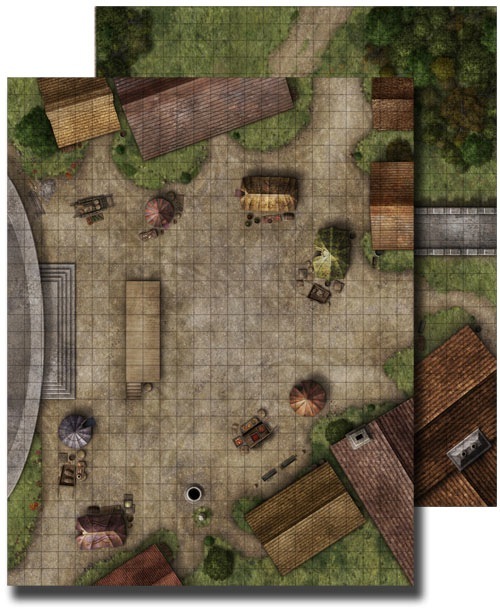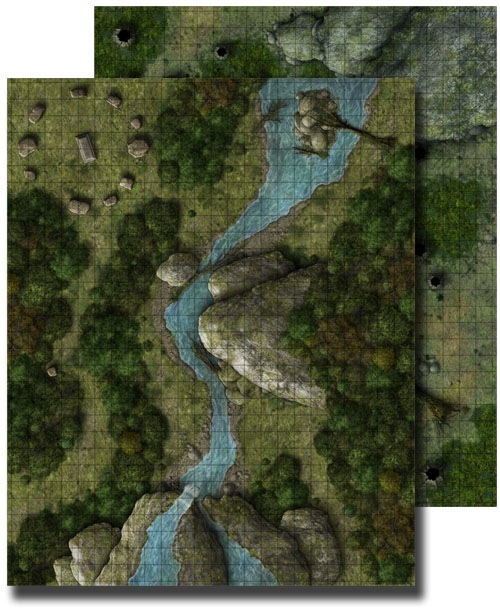Stormonu
NeoGrognard
Back when I got into D&D (around 1979), within a week of having scored the rulebooks for Christmas, the first thing I got my hands on were two sets of miniatures - Grenadier's Tomb of Spells (5004, 2nd version) and Woodland Adventurers (5003). My brother and I confiscated our mother's cardboard pattern sewing cutting board (36" X 60", I believe - similar to [ame="http://www.amazon.com/Cardboard-Pattern-Sewing-Cutting-Board-36/dp/B000G6DY2Y?tag=wwwtopharleya-20"]this[/ame], but without the extra lines) and using markers, turned into a miniature kingdom with a castle, haunted forest, minotaur maze and lava-strewn badland. For a nine-year-old and his brother who were big into action figures like Star Wars, soon-to-be GI Joe and the like, it was a Testor's-enamel-painted-lead-miniature heaven.
It was great until we realized that since we'd used markers to map the "world", we couldn't change it.
A little later on, we tried using our castle legos to build dungeons. The advantage was we could actually build the traps 'n stuff, but the problem was there wasn't many monsters that scaled well to it, and blocks-made-monsters looked rather sad.
By the time I was in college, I finally had enough money to buy a laminated grid mat - and was still expanding my lead/metal miniature collection. It was getting to the point I could cover just about every monster with it's correct miniature or a close proximity. If I didn't have it and couldn't proxy the creature with another mini, Sorry pawns or poker chips would fill in the ranks.
A few years later, on a trip to Seattle (to the WotC/TSR campus), I discovered Dwarven Forge. Over the next few years, I began to build up a large collection and set out several sprawling dungeons at the local Cons I attended. With the beauty of the DF pieces, using proxies (or unpainted minis) felt like a sin, and by then if I couldn't produce the correct mini or proxy it, it wasn't worth using the creature. (To this day, my kids love pulling out and building dungeons with DF pieces. They're not allowed to play with the lead minis, though).
However, toting two plastic file cabinets worth of Dwarven Forge stuff to a game became too much. When I was away from my house, I'd use a Chessex mat for my game. Sadly, I was very poor at taking care of them and more than once ruined them either by accidentally grabbing a dry erase marker or leaving red marker on the mat for one game night too many.
Next, WotC came out with the plastic minis. I began to replace my horde of painted and so-many-primed-I'll-never-have-time-to-paint minis with the much lighter, prepainted minis. I still occasionally paint minis for BBEG's and PCs, but I tend to use the plastics for everything else.
The next big shift was the arrival of Dungeon Tiles. With plastic minis and dungeon tiles, I finally hit my 3D medium. I have and still use them.
For a short stint in 3E, the RPGA group I was playing with used d12's glued to round bases for minis, whiteboard for the maps and tape measurers to track distances. It felt a little bizarre - like I was playing Warhammer Fantasy Battles, but it was fun in small doses.
I did try "papercraft" dungeons - I have a large collection of Fat Dragon Games and Worldswork Games print-your-own-tiles, and while they look great, they take more time to print out, cut and assemble than I generally have time for. I use them on occasion (I did put together Worldswork game's The Maiden for my pirate campaign) and they fill in some gaps that Dungeon Tiles just doesn't provide, but I can't say they've replaced my dungeon tiles.
Likewise, I've picked up several of Paizo's flip maps and WotC's DDM/map pack maps. They are beautiful set-piece maps, but the only problem I've run into is they tend to be good for one location; it can be difficult to reuse them in a way you really get your money out of them.
In the end, I think since I used to play with action figures so much in my youth, it's fun for me to set out minis and play with them at the table. While I've done stints without them and I tend to play every other RPG besides D&D without them, in the end I really like minis - to the point if I just had my character's mini sitting in front of me during a game I'd be pretty darn happy.
What has been the evolution of your use of mats, maps and minis? How have they affected your games and your interest in the game?
It was great until we realized that since we'd used markers to map the "world", we couldn't change it.
A little later on, we tried using our castle legos to build dungeons. The advantage was we could actually build the traps 'n stuff, but the problem was there wasn't many monsters that scaled well to it, and blocks-made-monsters looked rather sad.
By the time I was in college, I finally had enough money to buy a laminated grid mat - and was still expanding my lead/metal miniature collection. It was getting to the point I could cover just about every monster with it's correct miniature or a close proximity. If I didn't have it and couldn't proxy the creature with another mini, Sorry pawns or poker chips would fill in the ranks.
A few years later, on a trip to Seattle (to the WotC/TSR campus), I discovered Dwarven Forge. Over the next few years, I began to build up a large collection and set out several sprawling dungeons at the local Cons I attended. With the beauty of the DF pieces, using proxies (or unpainted minis) felt like a sin, and by then if I couldn't produce the correct mini or proxy it, it wasn't worth using the creature. (To this day, my kids love pulling out and building dungeons with DF pieces. They're not allowed to play with the lead minis, though).
However, toting two plastic file cabinets worth of Dwarven Forge stuff to a game became too much. When I was away from my house, I'd use a Chessex mat for my game. Sadly, I was very poor at taking care of them and more than once ruined them either by accidentally grabbing a dry erase marker or leaving red marker on the mat for one game night too many.
Next, WotC came out with the plastic minis. I began to replace my horde of painted and so-many-primed-I'll-never-have-time-to-paint minis with the much lighter, prepainted minis. I still occasionally paint minis for BBEG's and PCs, but I tend to use the plastics for everything else.
The next big shift was the arrival of Dungeon Tiles. With plastic minis and dungeon tiles, I finally hit my 3D medium. I have and still use them.
For a short stint in 3E, the RPGA group I was playing with used d12's glued to round bases for minis, whiteboard for the maps and tape measurers to track distances. It felt a little bizarre - like I was playing Warhammer Fantasy Battles, but it was fun in small doses.
I did try "papercraft" dungeons - I have a large collection of Fat Dragon Games and Worldswork Games print-your-own-tiles, and while they look great, they take more time to print out, cut and assemble than I generally have time for. I use them on occasion (I did put together Worldswork game's The Maiden for my pirate campaign) and they fill in some gaps that Dungeon Tiles just doesn't provide, but I can't say they've replaced my dungeon tiles.
Likewise, I've picked up several of Paizo's flip maps and WotC's DDM/map pack maps. They are beautiful set-piece maps, but the only problem I've run into is they tend to be good for one location; it can be difficult to reuse them in a way you really get your money out of them.
In the end, I think since I used to play with action figures so much in my youth, it's fun for me to set out minis and play with them at the table. While I've done stints without them and I tend to play every other RPG besides D&D without them, in the end I really like minis - to the point if I just had my character's mini sitting in front of me during a game I'd be pretty darn happy.
What has been the evolution of your use of mats, maps and minis? How have they affected your games and your interest in the game?






